Antimicrobial Use and Antimicrobial Resistance Indicators-Integration of Farm-Level Surveillance Data From Broiler Chickens and Turkeys in British Columbia, Canada
- PMID: 31131285
- PMCID: PMC6509235
- DOI: 10.3389/fvets.2019.00131
Antimicrobial Use and Antimicrobial Resistance Indicators-Integration of Farm-Level Surveillance Data From Broiler Chickens and Turkeys in British Columbia, Canada
Abstract
Using data from the Canadian Integrated Program for Antimicrobial Resistance Surveillance (CIPARS), we aimed to describe trends in antimicrobial use (AMU) in broiler chickens and turkeys, to compare AMU across species, to compare with trends in antimicrobial resistance (AMR), and to assess the effects of various AMU/AMR units of measurement (metrics and indicators) on data integration. Data on AMU and AMR in enteric bacteria, collected from 2013 to 2017 from broiler chickens (n = 143 flocks) and turkeys (n = 145) were used. In broiler chickens, the total AMU in milligrams/population correction unit (mg/PCUBr) decreased by 6%, the number (n) of defined daily doses for animals using Canadian standards (nDDDvetCA) per 1,000 broiler chicken-days decreased by 12%, and nDDDvetCA/PCU decreased by 6%. In turkeys, the mg/PCUTk decreased by 1%, whereas the nDDDvetCA/1,000 turkey-days and the nDDDvetCA/PCU increased by 1 and 5%, respectively. The types of antimicrobial classes used in both species were similar. Using the frequency of flocks reporting use (i.e., number of flocks reporting use/number of flocks participating) as a measurement, the use of certain antimicrobials changed over time (e.g., Broilers, decreased cephalosporin use, virginiamycin use, emerging use of lincomycin-spectinomycin, and avilamycin; Turkeys: increased trimethoprim-sulfonamides and macrolide use). The trends in resistance to specific antimicrobials paralleled the frequency and quantity of use (e.g., ceftriaxone use decreased-ceftriaxone resistance decreased, and gentamicin use increased-gentamicin resistance increased) in some situations, but not others (decreased fluoroquinolone use-increased ciprofloxacin resistance). AMR data were summarized using the AMR indicator index (AMR Ix). The most notable AMR Ix trend was the decrease in ceftriaxone AMR Ix among Escherichia coli (0.19 to 0.07); indicative of the success of the poultry industry action to eliminate the preventive use of third generation cephalosporins. Other trends observed were the increase in ciprofloxacin AMR Ix among Campylobacter from 0.23 to 0.41 and gentamicin AMR Ix among E. coli from 0.11 to 0.22, suggestive of the persistence/emergence of resistance related to previous and current AMU not captured in our surveillance timeframe. These data highlight the necessity of multiple AMU and AMR indicators for monitoring the impact of stewardship activities and interventions.
Keywords: Canada; farm-level; indicators; metrics; surveillance.
Figures
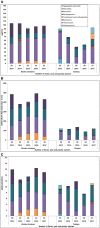
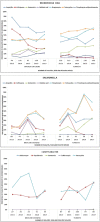
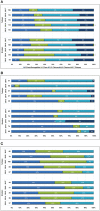
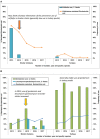
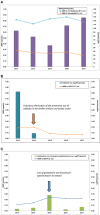
Similar articles
-
Antimicrobial use surveillance in broiler chicken flocks in Canada, 2013-2015.PLoS One. 2017 Jun 28;12(6):e0179384. doi: 10.1371/journal.pone.0179384. eCollection 2017. PLoS One. 2017. PMID: 28658278 Free PMC article.
-
Antimicrobials Used for the Therapy of Necrotic Enteritis and Coccidiosis in Broiler Chickens and Turkeys in Canada, Farm Surveillance Results (2013-2017).Avian Dis. 2019 Sep 1;63(3):433-445. doi: 10.1637/11971-091718-Reg.1. Avian Dis. 2019. PMID: 31967426
-
Antimicrobial Use Indices-The Value of Reporting Antimicrobial Use in Multiple Ways Using Data From Canadian Broiler Chicken and Turkey Farms.Front Vet Sci. 2020 Oct 19;7:567872. doi: 10.3389/fvets.2020.567872. eCollection 2020. Front Vet Sci. 2020. PMID: 33195547 Free PMC article.
-
Review of antimicrobial therapy of selected bacterial diseases in broiler chickens in Canada.Can Vet J. 2012 Dec;53(12):1289-300. Can Vet J. 2012. PMID: 23729827 Free PMC article. Review.
-
Antimicrobial therapy of selected diseases in turkeys, laying hens, and minor poultry species in Canada.Can Vet J. 2013 Nov;54(11):1041-52. Can Vet J. 2013. PMID: 24179239 Free PMC article. Review.
Cited by
-
Canadian Dairy Network for Antimicrobial Stewardship and Resistance (CaDNetASR): An On-Farm Surveillance System.Front Vet Sci. 2022 Jan 12;8:799622. doi: 10.3389/fvets.2021.799622. eCollection 2021. Front Vet Sci. 2022. PMID: 35097047 Free PMC article.
-
Quantification and Trends of Antimicrobial Use in Commercial Broiler Chicken Production in Pakistan.Antibiotics (Basel). 2021 May 18;10(5):598. doi: 10.3390/antibiotics10050598. Antibiotics (Basel). 2021. PMID: 34069928 Free PMC article.
-
A One-Health Genomic Investigation of Gentamicin Resistance in Salmonella from Human and Chicken Sources in Canada, 2014 to 2017.Antimicrob Agents Chemother. 2021 Nov 17;65(12):e0096621. doi: 10.1128/AAC.00966-21. Epub 2021 Sep 27. Antimicrob Agents Chemother. 2021. PMID: 34570642 Free PMC article.
-
Antimicrobial Susceptibility Profiles of Escherichia coli Isolates from Clinical Cases of Turkeys in Hungary (2022-2023).Antibiotics (Basel). 2025 Mar 25;14(4):338. doi: 10.3390/antibiotics14040338. Antibiotics (Basel). 2025. PMID: 40298482 Free PMC article.
-
Associations between antimicrobial resistance in fecal Escherichia coli isolates and antimicrobial use in Canadian turkey flocks.Front Microbiol. 2022 Jul 29;13:954123. doi: 10.3389/fmicb.2022.954123. eCollection 2022. Front Microbiol. 2022. PMID: 35966666 Free PMC article.
References
-
- Government of Canada Tackling Antimicrobial Resistance and Antimicrobial Use: A Pan-Canadian Framework for Action. (2017). Available online at: https://www.canada.ca/en/health-canada/services/publications/drugs-healt... - PMC - PubMed
-
- World Health Organization WHO Global Action Plan on Antimicrobial Resistance. (2015). Available online at: http://apps.who.int/iris/bitstream/10665/193736/1/9789241509763_eng.pdf?... - PubMed
-
- Food and Agriculture Organization of the United Nations The FAO Action Plan on Antimicrobial Resistance, 2016-2020. (2018). Available online at: http://www.fao.org/antimicrobial-resistance/en/.
-
- World Organization for Animal Health (OIE) The OIE Strategy on Antimicrobial Resistance and the Prudent Use of Antimicrobials. (2016). Available online at: http://www.oie.int/fileadmin/Home/eng/Media_Center/docs/pdf/PortailAMR/E...
-
- Food and Agriculture Organization of the United Nations World Organization for Animal Health and World Organization for Animal Health (OIE) Memorandum of Understanding Signed by FAO, OIE and WHO to Strengthen Their Long-Standing Partnership, With a Strong Focus on Tackling Antimicrobial Resistance. (2018). Available online at: http://www.who.int/zoonoses/MoU-Tripartite-May-2018.pdf?ua=1
LinkOut - more resources
Full Text Sources

